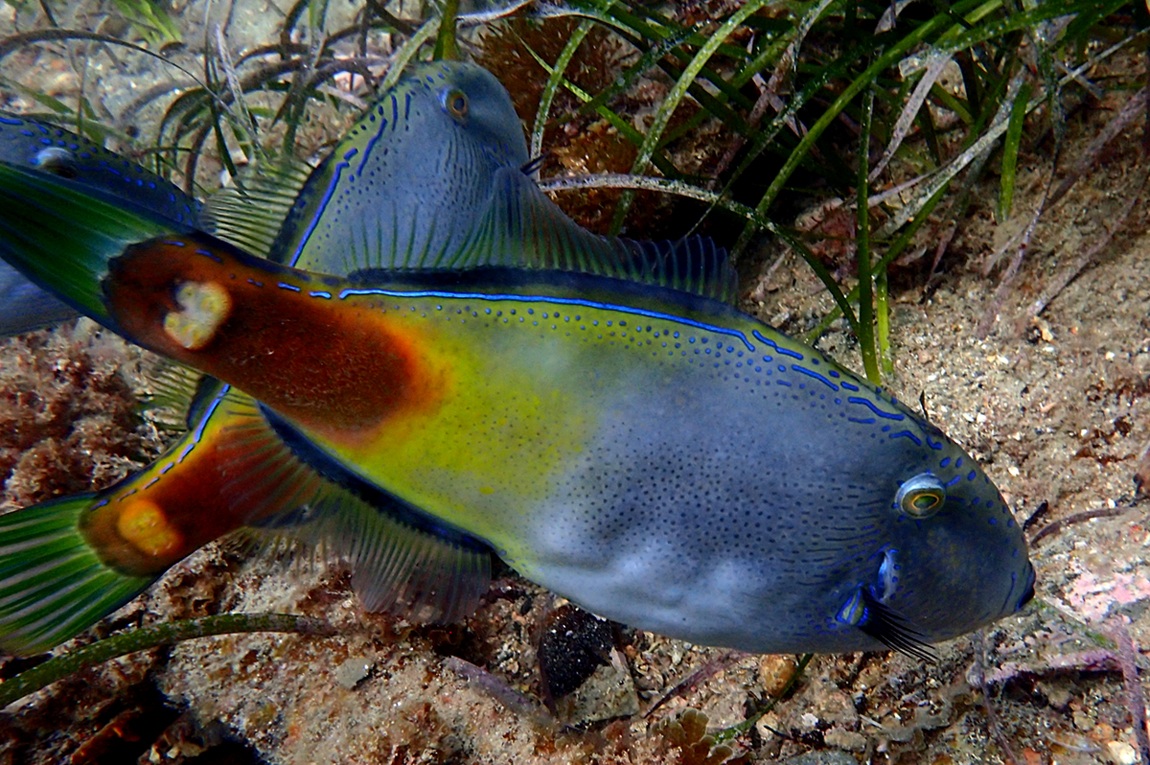Spinytail Leatherjacket, Acanthaluteres brownii (Richardson 1846)

Spinytail Leatherjackets, Acanthaluteres brownii, in Rapid Bay, South Australia, October 2019. Source: Glen Gitsham / iNaturalist.org. License: CC By Attribution-NonCommercial
Spinytail Leatherjackets in the Gulf St Vincent, South Australia
Spinytail Leatherjacket, Acanthaluteres brownii (Richardson 1846)
More Info
|
Distribution |
Endemic to southern Australia from Kangaroo Island and Rapid Head, South Australia, westwards to Shark Bay, Western Australia. Inhabits sheltered inshore reefs and adjacent seagrass beds in bays and coastal waters. Individuals sometimes form large schools. |
|
Features |
Dorsal fin II + 31-34; Anal fin 29-31; Caudal fin 12; Pectoral fin 10-11. Body oblong, of moderate depth, very compressed, with a small ventral flap; caudal peduncle shallow. Head large, broadly pointed; eyes small; mouth very small; teeth large, central pair in each jaw pointed, in single row; gill openings in form of small slit mostly above each pectoral fin base. Skin smooth to touch; two pairs of spines on each side of caudal peduncle, spines enlarged, curved forwards and preceded by dense patch of short bristles in adult males, small in adult females and juveniles; lateral line difficult to detect. Two dorsal fins, first dorsal above eyes, consisting of prominent four edged spine with row of downward directed barbs along each edge, spine wholly received into deep spinal groove when depressed, second dorsal widely separated from first, of moderate length, outer margin slightly convex in males and females; anal fin similar to and opposing second dorsal, not elevated anteriorly; caudal fin rounded. Pectoral fins moderately small, rounded. Pelvic fins reduced to a small but obvious rudiment, immovably attached to rear end of pelvis. |
|
Etymology |
The species is named brownii after Dr Robert Brown who allowed Richardson to examine Ferdinand Bauer's illustration of this species. |
|
Species Citation |
Aluterius? brownii Richardson 1846, Voy. Erebus and Terror: 68. Type locality: Coasts of Australia. (Based on an illustration by Ferdinand Bauer created during Matthew Flinder's circumnavigation of Australia) |
|
Author |
Bray, D.J. 2022 |
|
Resources |
Spinytail Leatherjacket, Acanthaluteres brownii (Richardson 1846)
References
Castelnau, F.L. de 1878. Australian fishes, new or little known species. Proceedings of the Linnean Society of New South Wales 1 2(3): 225-248 pls 1-2 (as Monacanthus yagoi) See ref at BHL
Edgar, G.J. 2008. Australian Marine Life: the plants and animals of temperate waters. Sydney : Reed New Holland 2nd edn, 624 pp.
Hollard, H.L. 1854. Monographie de la famille des balistides. Annales des Sciences Naturelles, Paris 4 2: 321-366 3 figs (as Monacanthus lineoguttatus)
Hoschke, A., Whisson, G. & Moore, G.I. 2019. Complete list of fishes from Rottnest Island. pp. 150-161 in Whisson, G. & Hoschke, A. (eds) The Rottnest Island fish book. 2nd ed. Perth.
Hutchins, J.B. 1977. Descriptions of three new genera and eight new species of monacanthid fishes from Australia. Records of the Western Australian Museum 5(1): 3-58 figs 1-13 (as Bigener brownii) See ref online
Hutchins, J.B. 1994. A survey of the nearshore reef fish fauna of Western Australia's west and south coasts — The Leeuwin Province. Records of the Western Australian Museum, Supplement 46: 1-66 figs 1-6
Hutchins, J.B. 1994. Family Monacanthidae. pp. 866-891 figs 767-787 in Gomon, M.F., Glover, C.J.M. & Kuiter, R.H. (eds). The Fishes of Australia's South Coast. Adelaide : State Printer 992 pp. 810 figs.
Hutchins, J.B. 2001. Biodiversity of shallow reef fish assemblages in Western Australia using a rapid censusing technique. Records of the Western Australian Museum 20: 247-270
Hutchins, J.B. 2008. Family Monacanthidae. pp. 822-841 in Gomon, M.F., Bray, D.J. & Kuiter, R.H. (eds). Fishes of Australia's Southern Coast. Sydney : Reed New Holland 928 pp.
Hutchins, J.B. & Swainston, R. 1986. Sea Fishes of Southern Australia. Complete field guide for anglers and divers. Perth : Swainston Publishing 180 pp.
Hutchins, J.B. & Thompson, M. 1983. The Marine and Estuarine Fishes of South-western Australia. Perth : Western Australian Museum 103 pp. 345 figs. (as Bigener brownii)
Kuiter, R.H. 1996. Guide to Sea Fishes of Australia. A comprehensive reference for divers and fishermen. Sydney, NSW, Australia : New Holland Publishers xvii, 434 pp.
Macleay, W.J. 1878. Descriptions of some new fishes from Port Jackson and King George's Sound. Proceedings of the Linnean Society of New South Wales 1 3(1): 33-37 pls 2-5 (as Monacanthus guttulatus)
Macleay, W.J. 1881. Descriptive catalogue of the fishes of Australia. Part 1. Proceedings of the Linnean Society of New South Wales 1 5(3): 302-444 (as ?Monacanthus castelnaui) See ref at BHL
Matsuura, K. 2015. Taxonomy and systematics of tetraodontiform fishes: a review focusing primarily on progress in the period from 1980 to 2014. Ichthyological Research 62(1): 72-113, https://doi.org/10.1007/s10228-014-0444-5
Matsuura, K., Motomura, H. & Khan, M. 2019. Acanthaluteres brownii. The IUCN Red List of Threatened Species 2019: e.T79800448A79800460. https://dx.doi.org/10.2305/IUCN.UK.2019-1.RLTS.T79800448A79800460.en. Downloaded on 21 May 2020.
May, J.L. & Maxwell, J.G.H. 1986. Field Guide to Trawl Fish from Temperate Waters of Australia. Hobart : CSIRO Division of Marine Research 492 pp. (as Bigener brownii)
Richardson, J. 1846. Ichthyology. 53-74 pls 31-41, 43-44 & 53 (part) in Richardson, J. & Gray, J.E. (eds). The Zoology of the Voyage of H.M.S. Erebus and Terror under the Command of Captain Sir James Clark Ross, R.N., F.R.S., during the years 1839–43. London : E.W. Janson Vol. 2 139 pp. See ref online












